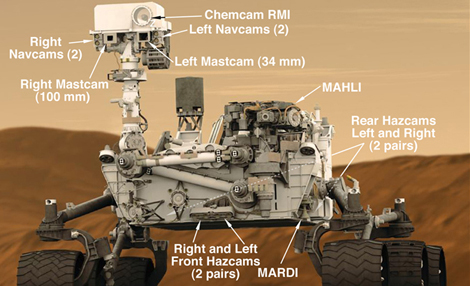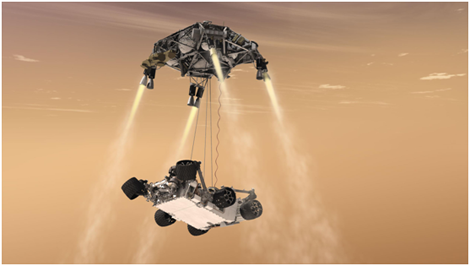 Once on the planet's surface, the scientific mission of the Curiosity. This real laboratory has a very large amount of scientific equipment:
Once on the planet's surface, the scientific mission of the Curiosity. This real laboratory has a very large amount of scientific equipment:
1. Three different camera types (manufactured by Malin Space Science Systems), all of which are redundant.
The system mastcam consists of 2 chambers true color high resolution and high memory capacity (images with a resolution of 1600×1200 pixels and videos of 1280×720 pixels and 10 fps and hardware compression); the system MAHLI (Mars Hand Lens Imager) composed of a camera mounted on the robotic arm of the Curiosity with the ability to take photos with 1600×1200 pixels (14.5 micrometers per pixel) equipped with various types of lighting and with the ability to store images in various formats with and without compression; and the system TUESDAY (Mars Descent Imager) used during the descent phase to document the entire process.
High resolution (MAHLI equivalent) will take images when the ground distance is between 3.7km and 5 meters, at a rate of 5 images per second;
2. A remote instrument called ChemCam composed of a laser, called LIBS (Laser-induced Breakdown Spectroscopy), and a system called remote micro imager (RMI).
With the laser, the Curiosity can vaporize an object 7 meters away, and the spectrum of light emitted is analyzed by the RMI.
The RMI can also, using the same optics, take images of the objects to be analyzed, as well as the result of the vaporization, having the capacity of resolutions from 1mm to 10m of distance.
This is a fabulous tool to select objects of interest that deserve a more rigorous analysis. Don't forget that the Curiosity is an explorer looking for signs of life;
3. An alpha particle x-ray spectrometer (APXS), which also equipped the two previous versions of robots that were placed on Mars.
With this device the Curiosity it can analyze the chemical composition of the samples under study, focusing beams of alpha particles and analyzing the resulting x-ray spectrum, which makes it possible to identify the exact chemical composition of the sample;
4. A device called CheMin which aims to detect minerals and their abundance on Mars.
In fact, this is yet another x-ray and fluorescence spectrometer that will work in conjunction with the robot arm and the tools placed at the end of the arm, namely the drill and the sampling devices.
Once obtained, the resulting powder is placed in the spectrometer for analysis. O Curiosity he is a true chemist and mineralogist;
5. Another instrument called SAM (Sample Analysis at Mars) and which aims to analyze the organic and gaseous composition of the Martian atmosphere, but also of samples collected by the robotic arm;

6. Another very interesting instrument is the RAD (Radiation Assessment Detector). It aims to analyze the radiation inside the ship during the entire voyage and during the surface placement phase.
It is the first time that this has been done and is intended to prepare a trip with crew members;
7. THE DAN (Dynamic Albedo of Neutrons), a neutron emitter and detector, is designed to detect hydrogen, ice or water on the surface of mars or just below the surface;
8. And a complete meteorological station (REMS - Rover Environmental Monitoring Station) with the ability to perfectly measure air and soil temperature, humidity, pressure, wind direction and ultraviolet radiation level;
9. Two camera navigation systems (NavCams) and problem detection (HazCams);
10. A very complex instrumentation system called MEDLI (Mars Entry, Descendant and Landing Instrumentation) which aims to measure all the variables necessary for the manipulation and control of the spacecraft.
NASA has not forgotten that it lost some spacecraft because it failed the measurement process during its descent to the planet, for example.
A real scientist. Fully equipped.
After having arrived, the Curiosity took a few hours to get operational. He had to lift his head, a mast that is essential for the operation of the various cameras and instruments on board.
Then he looked around, looked for objects and places that look interesting (his navigation system is very complete and autonomous), realized from a distance (with his laser and instruments) if the place deserves careful attention, making rigorous chemical analysis of the most interesting places, measuring everything, taking photos and making videos.
And we, here on earth, will receive daily the results of your scientific work, which is nothing more than the consequence of one of our most notable characteristics: the CURIOSITY of knowing more.
Read the first part of this article by clicking here.
(Full version in http://www.re-visto.com/curiosity)
 Author J. Norberto Pires is a professor at the Department of Mechanical Engineering at the University of Coimbra
Author J. Norberto Pires is a professor at the Department of Mechanical Engineering at the University of Coimbra
Science in the Regional Press


















Comments